Implementation of a Rainfall Normalization Module for GSMaP Microwave Imagers and Sounders
Abstract
:1. Introduction
2. Method
2.1. Data
2.2. MMN Algorithm
- The number of occurrences of each sensor for each surface type (ocean, land, and coast), each month (or the last 30 days), every 5° of latitude, and each 0.01 mm h−1 of rainfall intensity is accumulated from the PMW L3 hourly rainfall intensity. The rainfall intensity data under the orographic rainfall condition [19] are excluded because the differences between the look-up table for rain retrieval and the PMW algorithm cause a gap in rain estimates between orographic and non-orographic conditions and distort the correction table.
- The cumulative distribution function (CDF, the same as the percentile value) of rain intensity for each sensor (Ri, i denotes a given sensor) is calculated (hereafter, CDF at a given rainfall intensity and rainfall intensity at a given CDF denote CDF[Ri] and Ri[CDFi], respectively). Samples above the 99th percentile are not used to create the correction table; this excludes incorrect samples due to abnormal termination or malfunctions (e.g., upper limit). The correction table between the rainfall intensity at 99th percentile to 300 mm h−1 is linearly interpolated to reduce unstable conditions for heavy rainfall.
- A correction table (Tc) is created to replace the original rainfall intensity of each target sensor (Rt) with the rainfall intensity of the reference sensor (Rr) corresponding to the same CDF value, and to multiply the rainfall intensity of the target sensor by the ratio of each month (or the last 30 days) for the accumulated rainfall of the target (At) and reference sensors (Ar). Tc for a given Rt is defined as follows:
- The PMW L3 rainfall intensity is corrected using the correction table, except for the AMSR series (GW1_AM2 in this study), whose frequency and algorithm are close to COR_GMI. The oceanic table is used for the coastal region because of the small number of samples. Aside from this, the CDF, including non-rain samples, is also calculated. If the percentile at the lowest raining bin for the target MWI/MWS is lower than the reference value, the normalized rainfall becomes no-rain. For the polar side (above 60° of latitude), the correction table at 60° latitude is extrapolated considering the observation areas by the GPM Core Observatory with an inclination of 65°. For the standard version after the launch of the GPM Core Observatory, the reference sensor is COR_GMI. For the reanalysis version before the launch, TRM_TMI is used as a reference.
3. Result
3.1. Differences in CDF among PMW Sensors
3.2. Normalization Table
3.3. Evaluations of MMN Method
4. Discussion
5. Conclusions
Author Contributions
Funding
Data Availability Statement
Acknowledgments
Conflicts of Interest
Appendix A
| Acronyms | Platform | Sensor Name |
|---|---|---|
| COR_GMI | GPM Core Observatory | GPM Microwave Imager (GMI) |
| TRM_TMI | Tropical Rainfall Measuring Mission | TRMM Microwave Imager (TMI) |
| GW1_AM2 | Global Change Observation Mission 1st-Water | Advanced Microwave Scanning Radiometer 2 (AMSR2) |
| F16_MIS | Defense Meteorological Satellite Program F-16 | Special Sensor Microwave Imager Sounder (SSMIS) |
| F17_MIS | Defense Meteorological Satellite Program F-17 | |
| F18_MIS | Defense Meteorological Satellite Program F18 | |
| N18_MHS | National Oceanic and Atmospheric Administration 18 | Microwave Humidity Sounder (MHS) |
| N19_MHS | National Oceanic and Atmospheric Administration 19 | |
| NPP_ATS | Suomi National Polar-orbiting Partnership | Advanced Technology Microwave Sounder (ATMS) |
References
- Hou, A.Y.; Kakar, R.K.; Neeck, S.; Azarbarzin, A.A.; Kummerow, C.D.; Kojima, M.; Oki, R.; Nakamura, K.; Iguchi, T. The Global Precipitation Measurement Mission. Bull. Am. Meteorol. Soc. 2014, 95, 701–722. [Google Scholar] [CrossRef]
- Skofronick-Jackson, G.; Petersen, W.A.; Berg, W.; Kidd, C.; Stocker, E.F.; Kirschbaum, D.B.; Kakar, R.; Braun, S.A.; Huffman, G.J.; Iguchi, T.; et al. The Global Precipitation Measurement (GPM) Mission for Science and Society. Bull. Am. Meteorol. Soc. 2017, 98, 1679–1695. [Google Scholar] [CrossRef] [PubMed]
- Kubota, T.; Shige, S.; Hashizume, H.; Aonashi, K.; Takahashi, N.; Seto, S.; Hirose, M.; Takayabu, Y.N.; Nakagawa, K.; Iwanami, K.; et al. Global Precipitation Map using Satelliteborne Microwave Radiometers by the GSMaP Project: Production and Validation. IEEE Trans. Geosci. Remote Sens. 2007, 45, 2259–2275. [Google Scholar] [CrossRef]
- Aonashi, K.; Awaka, J.; Hirose, M.; Kozu, T.; Kubota, T.; Liu, G.; Shige, S.; Kida, S.; Seto, S.; Takahashi, N.; et al. GSMaP passive microwave precipitation retrieval algorithm: Algorithm description and validation. J. Meteorol. Soc. Jpn. 2009, 87, 119–136. [Google Scholar] [CrossRef]
- Shige, S.; Yamamoto, T.; Tsukiyama, T.; Kida, S.; Ashiwake, H.; Kubota, T.; Seto, S.; Aonashi, K.; Okamoto, K. The GSMaP precipitation retrieval algorithm for microwave sounders—Part I: Over-ocean algorithm. IEEE Trans. Geosci. Remote Sens. 2019, 47, 3084–3097. [Google Scholar] [CrossRef]
- Gentilucci, M.; Barbieri, M.; Pambianchi, G. Reliability of the IMERG product through reference rain gauges in Central Italy. Atmos. Res. 2022, 278, 106340. [Google Scholar] [CrossRef]
- Ning, S.; Song, F.; Udmale, P.; Jin, J.; Thapa, B.R.; Ishidaira, H. Error analysis and evaluation of the latest GSMaP and IMERG precipitation products over Eastern China. Adv. Meteorol. 2017, 2017, 1803492. [Google Scholar] [CrossRef]
- Kubota, T.; Shige, S.; Kachi, M.; Aonashi, K. Development of SSMIS rain retrieval algorithm in the GSMaP project. In Proceedings of the 25th International Symposium on Space Technology and Science, Okinawa, Japan, 5–12 June 2011. [Google Scholar]
- Joyce, R.J.; Janowiak, J.E.; Arkin, P.A.; Xie, P. CMORPH: A method that produces global precipitation estimates from passive microwave and infrared data at high spatial and temporal resolution. J. Hydrometeorol. 2004, 5, 487–503. [Google Scholar] [CrossRef]
- Joyce, R.J.; Xie, P. Kalman-filter-based CMORPH. J. Hydrometeorol. 2011, 12, 1547–1563. [Google Scholar] [CrossRef]
- Xie, P.; Joyce, R.; Wu, S.; Yoo, S.-H.; Yarosh, Y.; Sun, F.; Lin, R. Reprocessed, bias-corrected CMORPH global high-resolution precipitation estimates from 1998. J. Hydrometeorol. 2017, 18, 1617–1641. [Google Scholar] [CrossRef]
- Huffman, G.J.; Adler, R.F.; Bolvin, D.T.; Gu, G.; Nelkin, E.J.; Bowman, K.P.; Hong, Y.; Stocker, E.F.; Wolf, D.B. The TRMM Multisatelilte Precipitation Analysis (TMPA): Quasi-global, multiyear combined-sensor precipitation estimates and fine scales. J. Hydrometeorol. 2007, 8, 38–55. [Google Scholar] [CrossRef]
- Miller, J.R. A climatological Z-R relationship for convective storms in the northern Great Plains. In Proceedings of the 15th Radar Meteorology Conference, Champaign-Urbana, IL, USA, 10–12 October 1972; pp. 153–154. [Google Scholar]
- Krajewski, W.F.; Smith, J.A. On the estimation of climatological Z-R relationships. J. Appl. Meteorol. Climatol. 1991, 30, 1436–1445. [Google Scholar] [CrossRef]
- Huffman, G.J.; Bolvin, D.T.; Braithwaite, D.; Hsu, K.; Joyce, R.; Kidd, C.; Nelkin, E.J.; Sorooshian, S.; Tan, J.; Xie, P. Algorithm Theoretical Basis Document (ATBD) Version 06 NASA Global Precipitation Measurement (GPM) Integrated Multi-Satellite Retrievals for GPM (IMERG), National Aeronautics and Space Administration. 2020. Available online: https://gpm.nasa.gov/sites/default/files/2020-10/IMERG_doc_201006.pdf (accessed on 28 July 2022).
- Tan, J.; Petersen, W.A.; Tokay, A. A novel approach to identify sources of errors in IMERG for GPM ground validation. J. Hydrometeorol. 2016, 17, 2477–2491. [Google Scholar] [CrossRef]
- Yamamoto, M.K.; Kubota, T. Development of rainfall normalization module for GSMaP microwave imagers and sounders. In Proceedings of the International Geoscience and Remote Sensing Symposium, Waikoloa, HI, USA, 26 September–2 October 2020; pp. 3611–3614. [Google Scholar]
- Kubota, T.; Aonashi, K.; Ushio, T.; Shige, S.; Takayabu, Y.N.; Kachi, M.; Arai, Y.; Tashima, T.; Masaki, T.; Kawamoto, N.; et al. Global Satellite Mapping of Precipitation (GSMaP) Products in the GPM Era. In Satellite Precipitation Measurement; Levizzani, V., Kidd, C., Kirschbaum, D., Kummerow, C., Nakamura, K., Turk, J., Eds.; Advances in Global Change Research 67; Springer: Berlin/Heidelberg, Germany, 2020; pp. 355–373. [Google Scholar] [CrossRef]
- Yamamoto, M.K.; Shige, S. Implementation of an orographic/nonorographic rainfall classification scheme in the GSMaP algorithm for microwave radiometers. Atmos. Res. 2015, 163, 36–47. [Google Scholar] [CrossRef]
- Brief Description of GSMaP Version 04/Algorithm Version 7. Available online: https://www.eorc.jaxa.jp/GPM/doc/product_info/release_note_gsmapv04-v7_en.pdf (accessed on 28 July 2022).
- Seto, S.; Takahashi, N.; Iguchi, T. Rain/no-rain classification method for microwave radiometer observations over land using statistical information for brightness temperature under no-rain conditions. J. Appl. Meteorol. Climatol. 2005, 44, 1243–1259. [Google Scholar] [CrossRef] [Green Version]
- Olson, W.S. GPM Combined Radar-Radiometer Algorithm Team: GPM Combined Radar-Radiometer Precipitation Algorithm Theoretical Basis Document (Version 5). 2018. Available online: https://gpm.nasa.gov/sites/default/files/2020-05/Combined_algorithm_ATBD.V05.pdf (accessed on 28 July 2022).
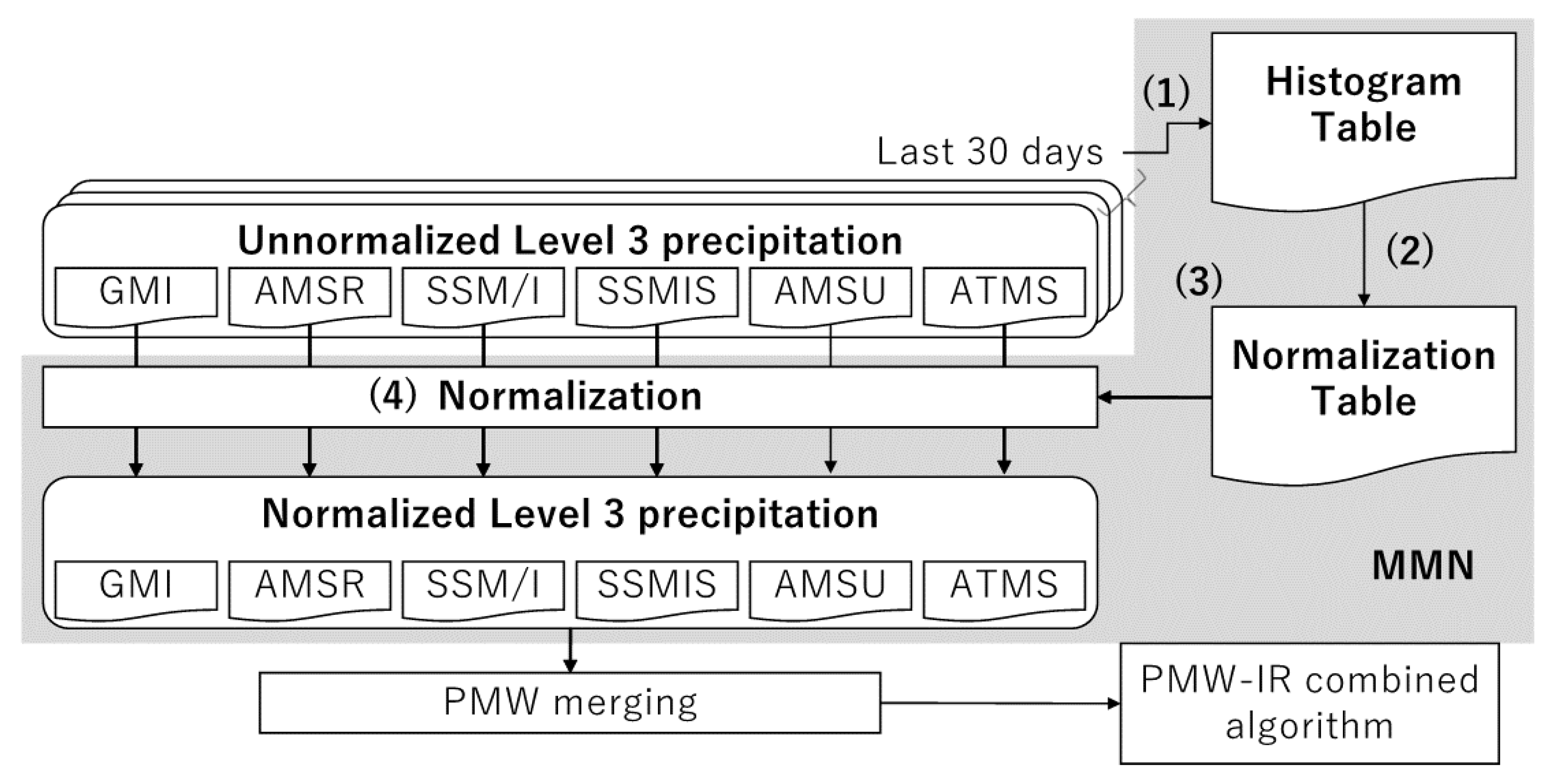
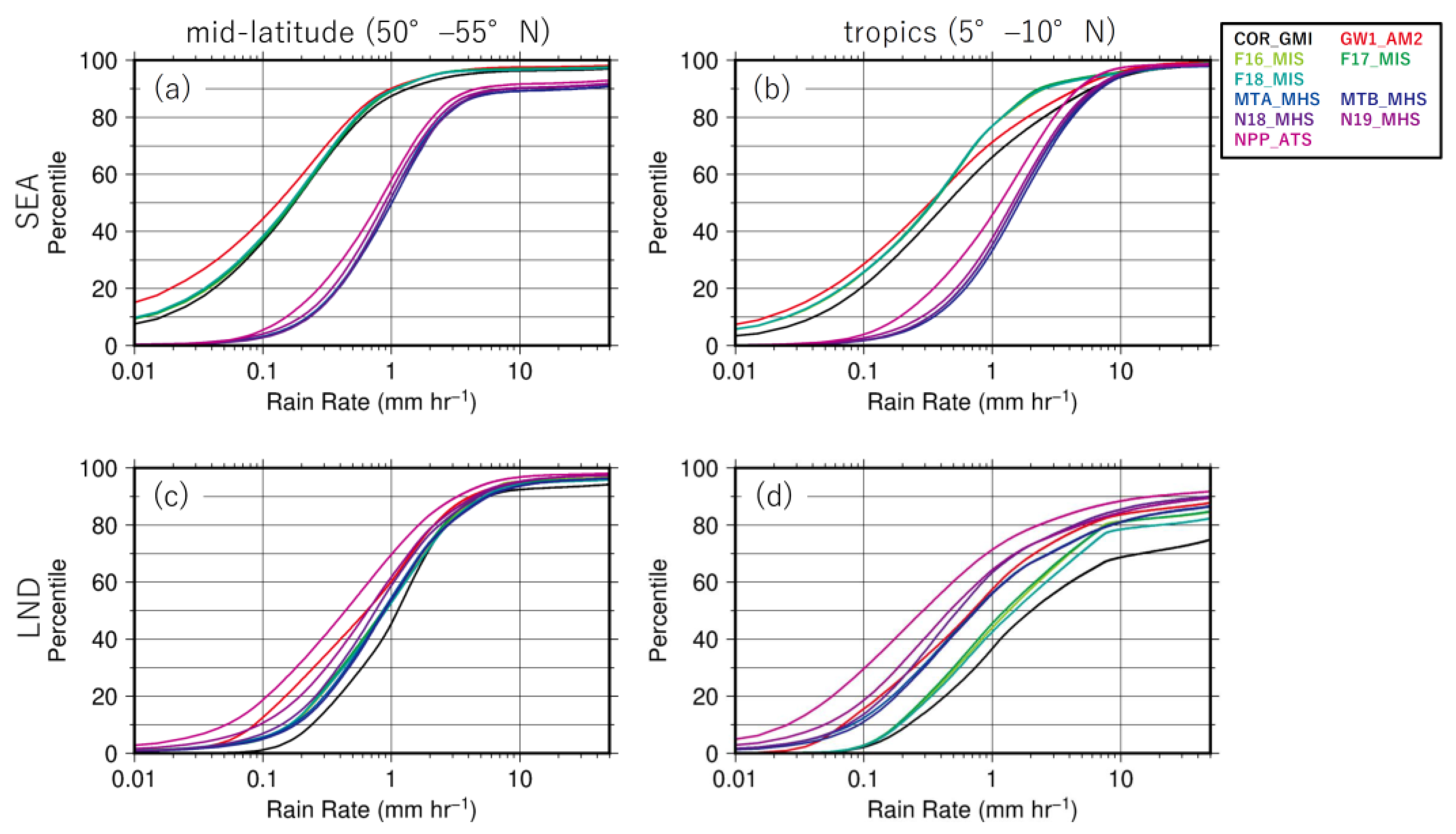
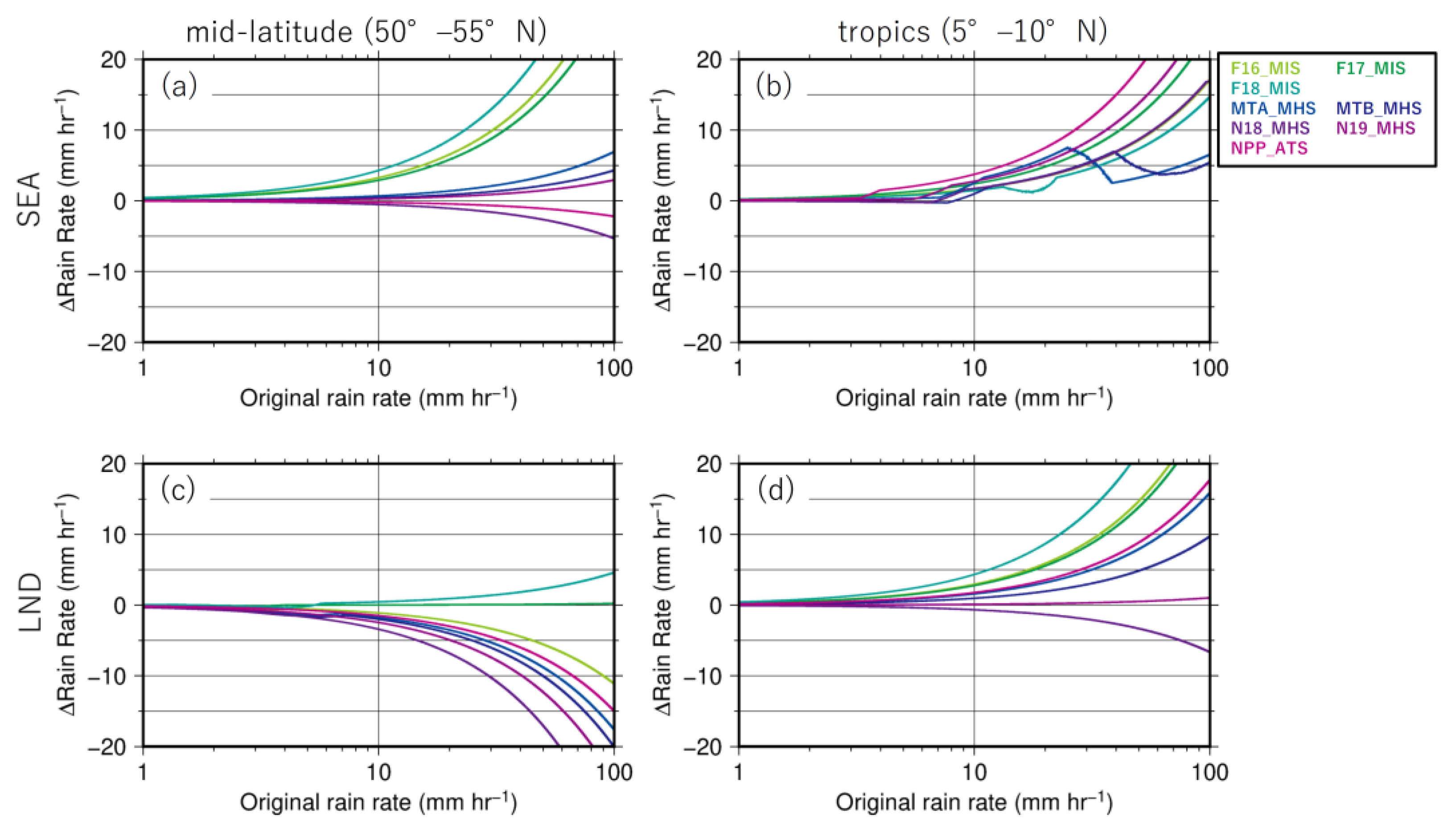
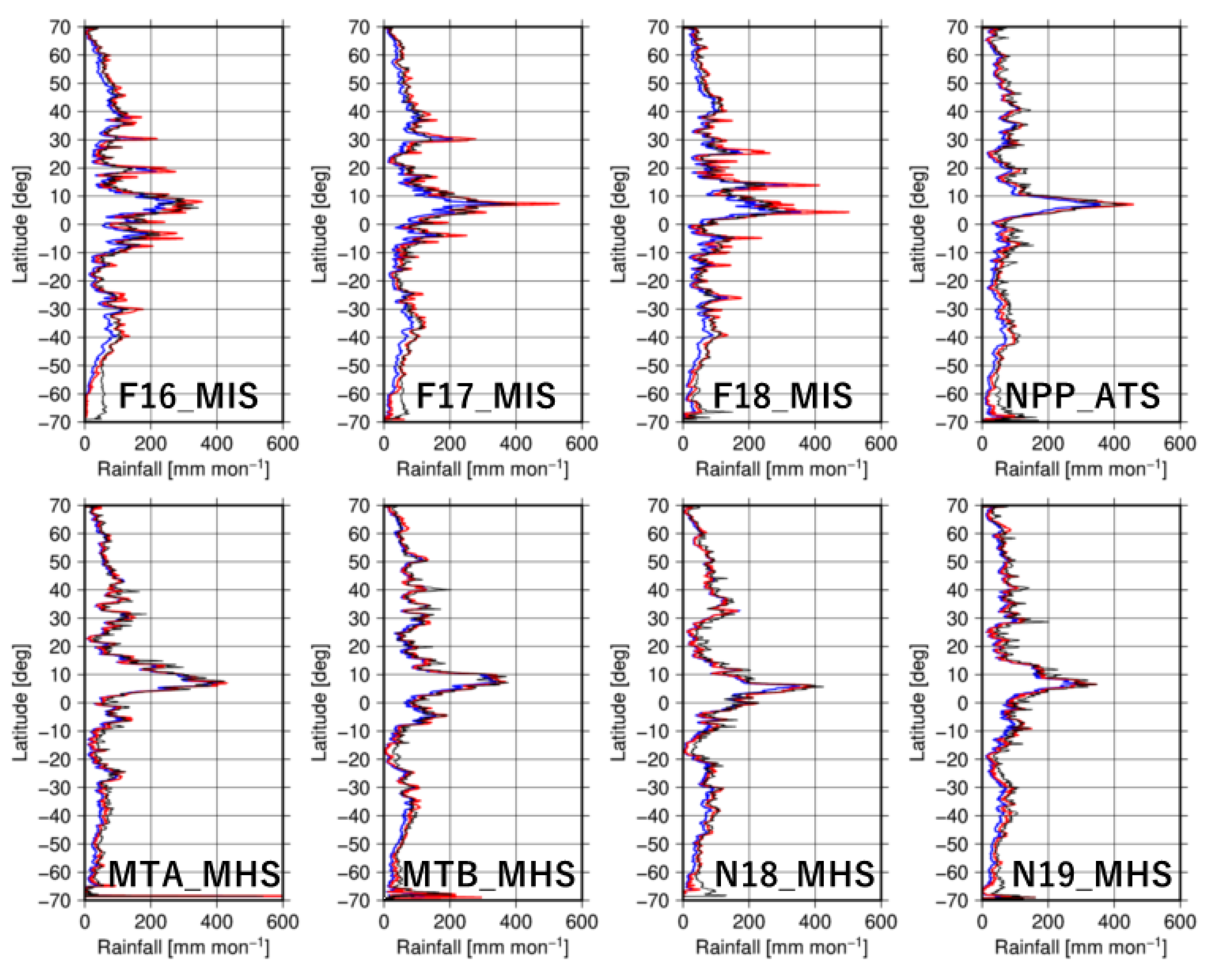
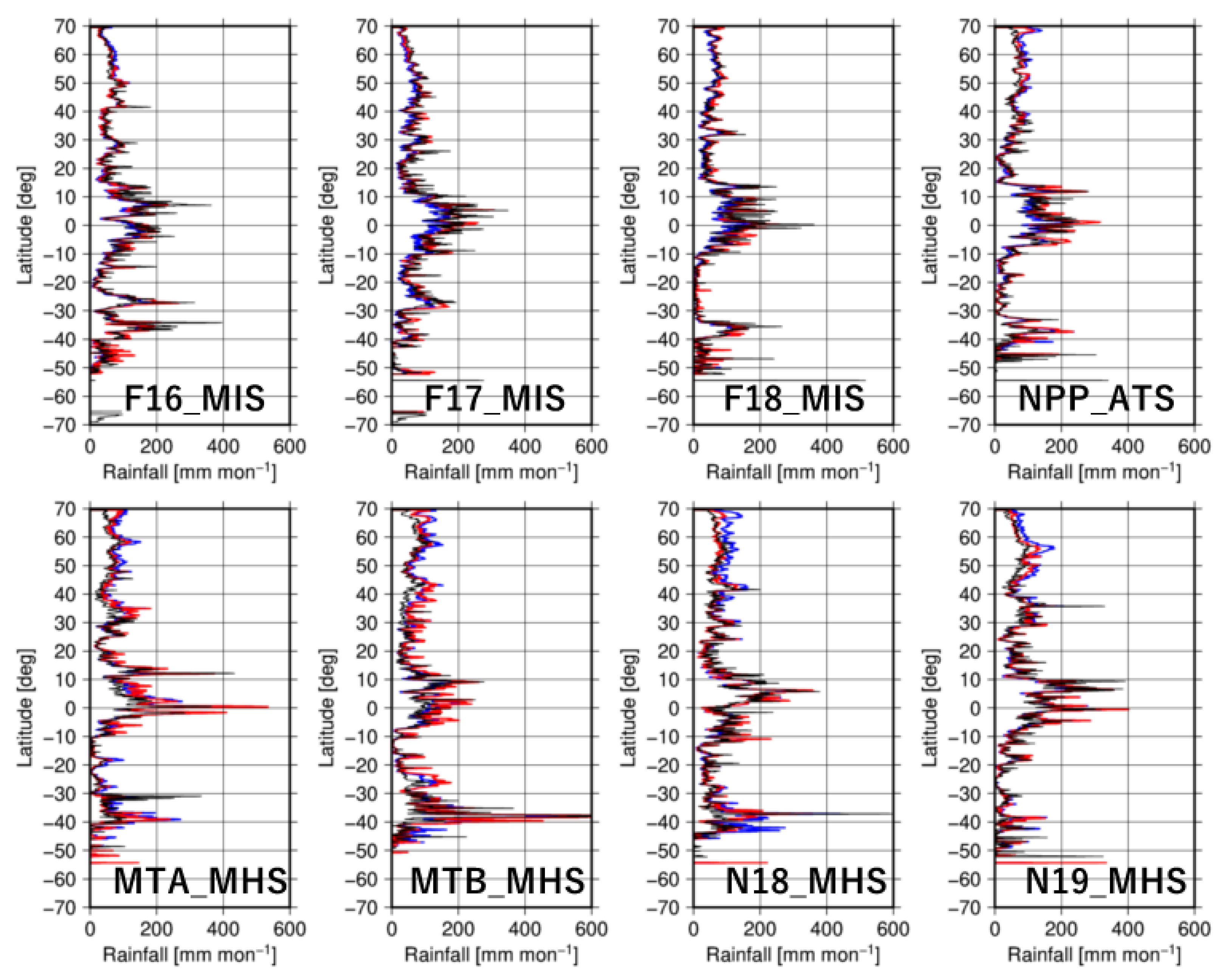
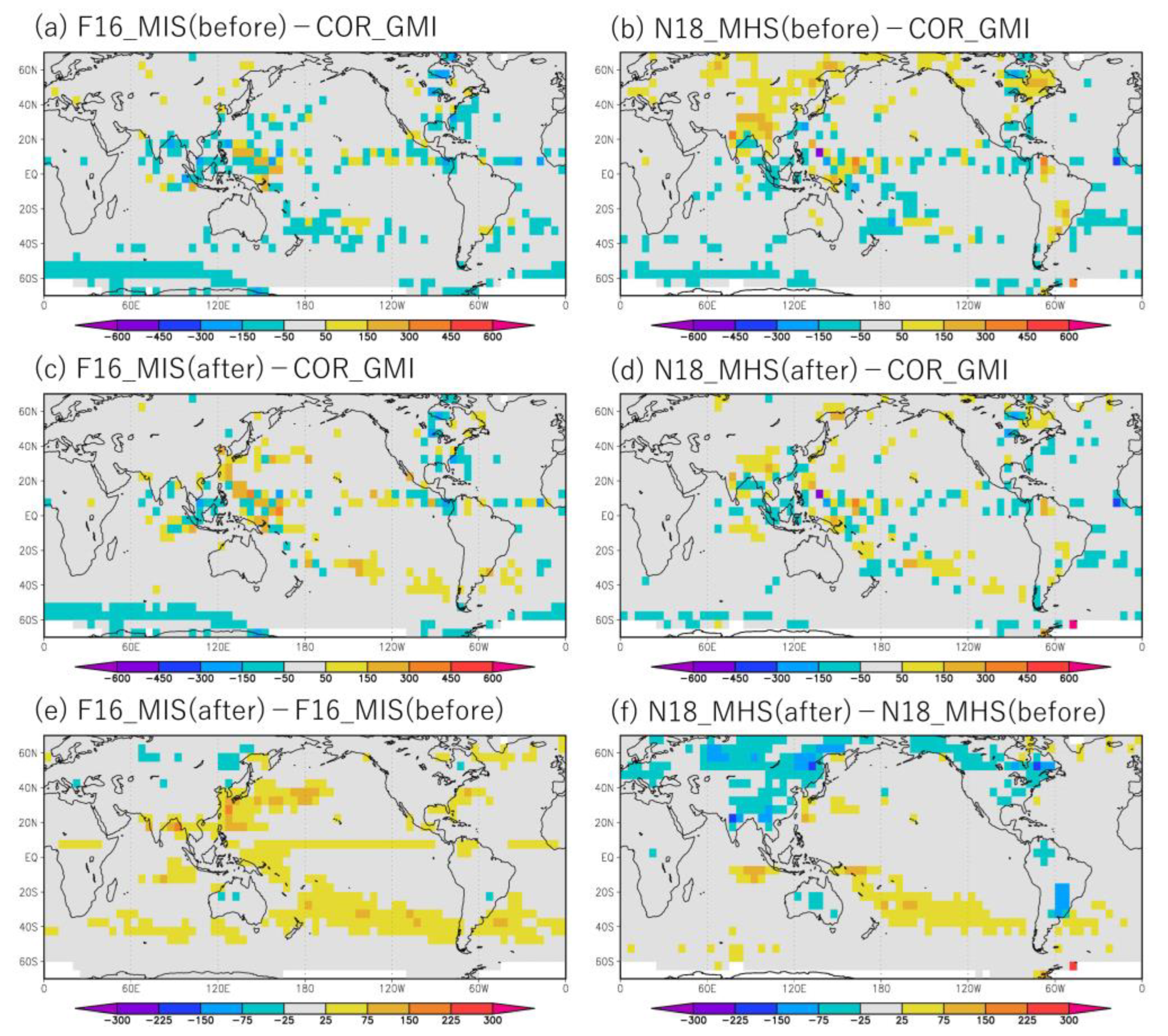
| Freq. | GMI | TMI, AMSR | SSM/I | SSMIS | AMSU, MHS, ATMS |
|---|---|---|---|---|---|
| 10 GHz | ○ | ○ | |||
| 19 GHz | ○ | ○ | ○ | ○ | |
| 23/31 GHz | ○ | ○ | ○ | ○ | ○ |
| 37 GHz | ○ | ○ | ○ | ○ | |
| 85 GHz | ○ | ○ | ○ | ○ | ○ |
| >100 GHz | ○ | ○ | ○ | ||
| Scan method | Conical | Cross-track | |||
| Sensor | SEA | LND | ||
|---|---|---|---|---|
| Uncorrected | Corrected | Uncorrected | Corrected | |
| F16_MIS | −0.037 | −0.012 | 0.001 | −0.003 |
| F17_MIS | −0.034 | −0.005 | −0.019 | −0.006 |
| F18_MIS | −0.027 | 0.004 | −0.010 | 0.006 |
| MTA_MHS | −0.022 | −0.009 | 0.028 | 0.017 |
| MTB_MHS | −0.021 | −0.005 | 0.032 | 0.027 |
| N18_MHS | −0.024 | −0.009 | 0.030 | 0.002 |
| N19_MHS | −0.031 | −0.013 | 0.026 | 0.011 |
| NPP_ATS | −0.034 | −0.015 | 0.014 | 0.010 |
| Sensor | SEA | LND | ||
|---|---|---|---|---|
| Uncorrected | Corrected | Uncorrected | Corrected | |
| F16_MIS | 0.665 | 0.834 | 0.677 | 0.671 |
| F17_MIS | 0.584 | 0.752 | 0.644 | 0.641 |
| F18_MIS | 0.709 | 0.950 | 0.661 | 0.673 |
| MTA_MHS | 0.550 | 0.575 | 0.732 | 0.718 |
| MTB_MHS | 0.551 | 0.585 | 0.758 | 0.782 |
| N18_MHS | 0.521 | 0.554 | 0.828 | 0.791 |
| N19_MHS | 0.516 | 0.546 | 0.837 | 0.828 |
| NPP_ATS | 0.517 | 0.535 | 0.734 | 0.740 |
| Sensor | SEA | LND | ||
|---|---|---|---|---|
| Uncorrected | Corrected | Uncorrected | Corrected | |
| F16_MIS | 0.587 | 0.593 | 0.587 | 0.598 |
| F17_MIS | 0.633 | 0.634 | 0.654 | 0.656 |
| F18_MIS | 0.630 | 0.632 | 0.602 | 0.601 |
| MTA_MHS | 0.684 | 0.674 | 0.580 | 0.578 |
| MTB_MHS | 0.656 | 0.652 | 0.597 | 0.582 |
| N18_MHS | 0.680 | 0.669 | 0.561 | 0.567 |
| N19_MHS | 0.671 | 0.660 | 0.567 | 0.560 |
| NPP_ATS | 0.648 | 0.644 | 0.503 | 0.504 |
Publisher’s Note: MDPI stays neutral with regard to jurisdictional claims in published maps and institutional affiliations. |
© 2022 by the authors. Licensee MDPI, Basel, Switzerland. This article is an open access article distributed under the terms and conditions of the Creative Commons Attribution (CC BY) license (https://creativecommons.org/licenses/by/4.0/).
Share and Cite
Yamamoto, M.K.; Kubota, T. Implementation of a Rainfall Normalization Module for GSMaP Microwave Imagers and Sounders. Remote Sens. 2022, 14, 4445. https://doi.org/10.3390/rs14184445
Yamamoto MK, Kubota T. Implementation of a Rainfall Normalization Module for GSMaP Microwave Imagers and Sounders. Remote Sensing. 2022; 14(18):4445. https://doi.org/10.3390/rs14184445
Chicago/Turabian StyleYamamoto, Munehisa K., and Takuji Kubota. 2022. "Implementation of a Rainfall Normalization Module for GSMaP Microwave Imagers and Sounders" Remote Sensing 14, no. 18: 4445. https://doi.org/10.3390/rs14184445
APA StyleYamamoto, M. K., & Kubota, T. (2022). Implementation of a Rainfall Normalization Module for GSMaP Microwave Imagers and Sounders. Remote Sensing, 14(18), 4445. https://doi.org/10.3390/rs14184445







